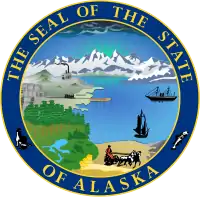Exxon Valdez oil spill
The Exxon Valdez oil spill occurred in Prince William Sound, Alaska, March 24, 1989, when the Exxon Valdez, an oil tanker owned by Exxon Shipping Company, bound for Long Beach, California, struck Prince William Sound's Bligh Reef, 1.5 mi (2.4 km) west of Tatitlek, Alaska, at 12:04 a.m. and spilled 10.8 million US gallons (257,000 bbl) (or 37,000 tonnes)[1] of crude oil over the next few days.[2] It is considered the worst oil spill worldwide in terms of damage to the environment.[3] The Valdez spill is the second largest in US waters, after the 2010 Deepwater Horizon oil spill, in terms of volume released.[4][5] Prince William Sound's remote location, accessible only by helicopter, plane, or boat, made government and industry response efforts difficult and severely taxed existing response plans. The region is a habitat for salmon, sea otters, seals and seabirds. The oil, originally extracted at the Prudhoe Bay Oil Field, eventually affected 1,300 miles (2,100 km) of coastline, of which 200 miles (320 km) were heavily or moderately oiled.[2][6][7]
| Exxon Valdez oil spill | |
|---|---|
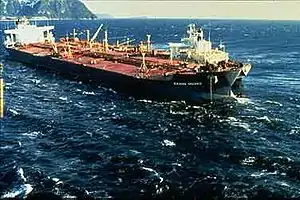 Three days after Exxon Valdez ran aground | |

| |
| Location | Prince William Sound, Alaska |
| Coordinates | 60.8408°N 146.8625°W |
| Date | March 24, 1989 |
| Cause | |
| Cause | Grounding of the Exxon Valdez oil tanker |
| Operator | Exxon Shipping Company |
| Spill characteristics | |
| Volume | 10.8×106 US gal (260,000 bbl; 41,000 m3) (or 37,000 metric tonnes) |
| Shoreline impacted | 1,300 mi (2,100 km) |
Spill
The ship was carrying 53.1 million US gallons (1,260,000 bbl; 201,000 m3) of oil, of which about 10.8 million US gallons (260,000 bbl; 41,000 m3) were spilled into the Prince William Sound.[2][4][8][9][10]
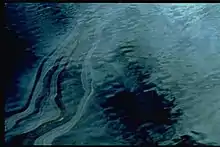
Multiple factors have been identified as contributing to the incident:
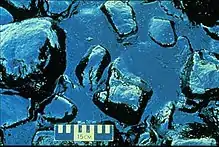
- Exxon Shipping Company failed to supervise the master and provide a rested and sufficient crew for Exxon Valdez. The NTSB found this was widespread throughout the industry, prompting a safety recommendation to Exxon and to the industry.[12]
- The third mate failed to properly maneuver the vessel, possibly due to fatigue or excessive workload.[12]
- Exxon Shipping Company failed to properly maintain the Raytheon Collision Avoidance System (RAYCAS) radar, which, if functional, would have indicated to the third mate an impending collision with the Bligh Reef by detecting the "radar reflector," placed on the next rock inland from Bligh Reef for the purpose of keeping ships on course. This cause was brought forward by Greg Palast and is not present in the official accident report.[13]
Captain Joseph Hazelwood, who was widely reported to have been drinking heavily that night, was not at the controls when the ship struck the reef. Exxon blamed Captain Hazelwood for the grounding of the tanker, but, Hazelwood accused the corporation of making him a scapegoat.[13][14] As the senior officer in command of the ship, he was accused of being intoxicated and thereby contributing to the disaster, but he was cleared of this charge at his 1990 trial after witnesses testified that he was sober around the time of the accident . Writer Greg Palast stated in 2008, "Forget the drunken skipper fable. As to Captain Joe Hazelwood, he was below decks, sleeping off his bender. At the helm, the third mate may never have collided with Bligh Reef had he looked at his RAYCAS radar. But the radar was not turned on. In fact, the tanker's radar was left broken and disabled for more than a year before the disaster, and Exxon management knew it. It was just too expensive to fix and operate."[15] However, though Greg Palast’s article (which is also embellished with specific reference to somewhat mysterious perhaps colloquially named “rubber and sucker” systems, and, ambiguous diction where it references the acronym “BP” in terms of its relationship to British Petroleum) tells us to “Forget the drunken skipper fable”, and, whether or not directly relevant to the circumstances of the disaster in terms of the extent of Hazelwood’s direct involvement, Bill Meyer in his U.S. News article which includes references to an interview with Hazelwood claims that “(Hazelwood) doesn't say much about the actual grounding, which occurred just after midnight on March 24, 1989”, though of Hazelwood’s trip ashore, approximately 12 hours before the accident, he says Hazelwood reported that “after lunch, we had a couple of drinks”. [14] Of the culture in play at the time it is perhaps reasonable to ask: “why, if (as Greg Palast suggests they might have) the Captain and ship’s officers had knowledge of the absence of functioning radar and cleanup systems, did the ship set sail with them collectively at the helm in the first place, whatever the specifics in terms of who’s watch?”.
Other factors, according to an MIT course entitled "Software System Safety" by Professor Nancy G. Leveson,[16] included:
- Ships were not informed that the previous practice of the Coast Guard tracking ships out to Bligh Reef had ceased.[17]
- The oil industry promised, but never installed, state-of-the-art iceberg monitoring equipment.[18]
- Exxon Valdez was sailing outside the normal sea lane to avoid small icebergs thought to be in the area.[18]
- Coast Guard vessel inspections in Valdez were not performed, and the number of staff was reduced.[19]
- Lack of available equipment and personnel hampered the spill cleanup.[17]
This disaster resulted in International Maritime Organization introducing comprehensive marine pollution prevention rules (MARPOL) through various conventions. The rules were ratified by member countries and, under International Ship Management rules, the ships are being operated with a common objective of "safer ships and cleaner oceans." [20]
In 2009, Exxon Valdez Captain Joseph Hazelwood offered a "heartfelt apology" to the people of Alaska, suggesting he had been wrongly blamed for the disaster: "The true story is out there for anybody who wants to look at the facts, but that's not the sexy story and that's not the easy story," he said. Hazelwood said he felt Alaskans always gave him a fair shake.[14]
Clean-up and major effects
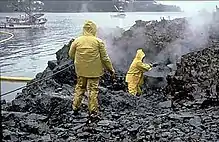
Chemical dispersant, a surfactant and solvent mixture, was applied to the slick by a private company on March 24 with a helicopter, but the helicopter missed the target area. Scientific data on its toxicity were either thin or incomplete. In addition, public acceptance of a new, widespread chemical treatment was lacking. Landowners, fishing groups, and conservation organizations questioned the use of chemicals on hundreds of miles of shoreline when other alternatives may have been available."[21][22][23]
According to a report by David Kirby for TakePart, the main component of the Corexit formulation used during cleanup, 2-butoxyethanol, was identified as "one of the agents that caused liver, kidney, lung, nervous system, and blood disorders among cleanup crews in Alaska following the 1989 Exxon Valdez spill.[24]
Mechanical cleanup was started shortly afterwards using booms and skimmers, but the skimmers were not readily available during the first 24 hours following the spill, and thick oil and kelp tended to clog the equipment. Despite civilian insistence for a complete clean, only 10% of total oil was actually completely cleaned. Exxon was widely criticized for its slow response to cleaning up the disaster and John Devens, the mayor of Valdez, has said his community felt betrayed by Exxon's inadequate response to the crisis.[25] More than 11,000 Alaska residents, along with some Exxon employees, worked throughout the region to try to restore the environment.
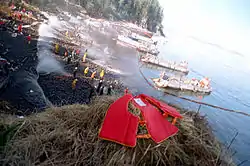
Because Prince William Sound contained many rocky coves where the oil collected, the decision was made to displace it with high-pressure hot water. However, this also displaced and destroyed the microbial populations on the shoreline; many of these organisms (e.g. plankton) are the basis of the coastal marine food chain, and others (e.g. certain bacteria and fungi) are capable of facilitating the biodegradation of oil. At the time, both scientific advice and public pressure was to clean everything, but since then, a much greater understanding of natural and facilitated remediation processes has developed, due somewhat in part to the opportunity presented for study by the Exxon Valdez spill. Despite the extensive cleanup attempts, less than ten percent of the oil was recovered.
Both the long-term and short-term effects of the oil spill have been studied.[26] Immediate effects included the deaths of 100,000 to as many as 250,000 seabirds, at least 2,800 sea otters, approximately 12 river otters, 300 harbor seals, 247 bald eagles, and 22 orcas, and an unknown number of salmon and herring.[8][27]
Although the volume of oil has declined considerably with oil remaining only about 0.14–0.28% of the original spilled volume, studies suggest the area of oiled beach has changed little since 1992.[28] A study by the National Marine Fisheries Service, NOAA in Juneau, determined that by 2001 approximately 90 tonnes of oil remained on beaches in Prince William Sound in the sandy soil of the contaminated shoreline, with annual loss rates declining from 68% per year prior to 1992, to 4% per year after 2001.[29][30]

The remaining oil lasting far longer than anticipated has resulted in more long-term losses of species than had been expected. Laboratory experiments found that at levels as low as one part per billion, polycyclic aromatic hydrocarbons are toxic for salmon and herring eggs. Species as diverse as sea otters, harlequin ducks and orcas suffered immediate and long-term losses. Oiled mussel beds and other tidal shoreline habitats may take up to 30 years to recover.[30]
ExxonMobil denied concerns over remaining oil, stating that they anticipated the remaining fraction would not cause long-term ecological impacts. According to the conclusions of ExxonMobil's study: "We've done 350 peer-reviewed studies of Prince William Sound, and those studies conclude that Prince William Sound has recovered, it's healthy and it's thriving."[31]
On March 24, 2014, the twenty-fifth anniversary of the spill, NOAA scientists reported that some species seem to have recovered, with the sea otter the latest creature to return to pre-spill numbers. Scientists who have monitored the spill area for the last 25 years report that concern remains for one of two pods of local orca whales, with fears that one pod may eventually die out.[32] Federal scientists estimate that between 16,000 and 21,000 US gallons (61 to 79 m3) of oil remains on beaches in Prince William Sound and up to 450 miles (725 km) away. Some of the oil does not appear to have biodegraded at all. A USGS scientist who analyses the remaining oil along the coastline states that it remains among rocks and between tide marks. "The oil mixes with seawater and forms an emulsion...Left out, the surface crusts over but the inside still has the consistency of mayonnaise – or mousse."[33] Alaska state senator Berta Gardner is urging Alaskan politicians to demand that the US government force ExxonMobil to pay the final $92 million (£57 million) still owed from the court settlement. The major part of the money would be spent to finish cleaning up oiled beaches and attempting to restore the crippled herring population.[33]
Litigation and cleanup costs

In October 1989, Exxon filed suit against the State of Alaska, charging that the state had interfered with Exxon's attempts to clean up the spill by refusing to approve the use of dispersant chemicals until the night of the 26th. The state disputed the claim, stating that there was a long-standing agreement to allow the use of dispersants to clean up spills, thus Exxon did not require permission to use them, and that in fact Exxon had not had enough dispersant on hand to effectively handle a spill of the size created by the Valdez.[34] Exxon filed claims in October 1990 against the Coast Guard, asking to be reimbursed for cleanup costs and damages awarded to plaintiffs in any lawsuits filed by the State of Alaska or the federal government against Exxon. The company claimed that the Coast Guard was "wholly or partially responsible" for the spill, because they had granted mariners' licenses to the crew of the Valdez, and because they had given the Valdez permission to leave regular shipping lanes to avoid ice. They also reiterated the claim that the Coast Guard had delayed cleanup by refusing to give permission to immediately use chemical dispersants on the spill.[35]
Also, in 1991, Exxon made a quiet, separate financial settlement of damages with a group of seafood producers known as the Seattle Seven for the disaster's effect on the Alaskan seafood industry. The agreement granted $63.75 million to the Seattle Seven, but stipulated that the seafood companies would have to repay almost all of any punitive damages awarded in other civil proceedings. The $5 billion in punitive damages was awarded later, and the Seattle Seven's share could have been as high as $750 million if the damages award had held. Other plaintiffs have objected to this secret arrangement,[36] and when it came to light, Judge Holland ruled that Exxon should have told the jury at the start that an agreement had already been made, so the jury would know exactly how much Exxon would have to pay.[37]
In the case of Exxon v. Baker, an Anchorage jury awarded $287 million for actual damages and $5 billion for punitive damages. To protect itself in case the judgment was affirmed, Exxon obtained a $4.8 billion credit line from J.P. Morgan & Co., who created the first modern credit default swap so that they would not have to hold as much money in reserve against the risk of Exxon's default.[38]
Meanwhile, Exxon appealed the ruling, and the 9th U.S. Circuit Court of Appeals ordered the trial judge, Russel Holland, to reduce the punitive damages. On December 6, 2002, Holland announced that he had reduced the damages to $4 billion, which he concluded was justified by the facts of the case and was not grossly excessive. Exxon appealed again and the case returned to Holland to be reconsidered in light of a recent Supreme Court ruling in a similar case. Holland increased the punitive damages to $4.5 billion, plus interest.[39]
After more appeals, in December 2006 the damages award was cut to $2.5 billion. The court of appeals cited recent Supreme Court rulings relative to limits on punitive damages.[40]
Exxon appealed again. On May 23, 2007, the 9th Circuit Court of Appeals denied ExxonMobil's request for a third hearing and let stand its ruling that Exxon owed $2.5 billion in punitive damages. Exxon then appealed to the Supreme Court, which agreed to hear the case.[41] On February 27, 2008, the Supreme Court heard oral arguments. Justice Samuel Alito, who at the time owned between $100,000 and $250,000 in Exxon stock, recused himself from the case.[42] In a decision issued June 25, 2008, written by Justice David Souter, the court vacated the $2.5 billion award and remanded the case back to the lower court, finding that the damages were excessive with respect to maritime common law. Exxon's actions were deemed "worse than negligent but less than malicious."[43] The punitive damages were further reduced to an amount of $507.5 million.[44] The Court's ruling was that maritime punitive damages should not exceed the compensatory damages,[44] supported by a precedent dating from 1818.[45] Senate Judiciary Committee Chairman Patrick J. Leahy has decried the ruling as "another in a line of cases where this Supreme Court has misconstrued congressional intent to benefit large corporations."[46]
Exxon's official position was that punitive damages greater than $25 million were not justified because the spill resulted from an accident, and because Exxon spent an estimated $2 billion cleaning up the spill and a further $1 billion to settle related civil and criminal charges. Attorneys for the plaintiffs contended that Exxon bore responsibility for the accident because the company "put a drunk in charge of a tanker in Prince William Sound."[47] Exxon recovered a significant portion of clean-up and legal expenses through insurance claims associated with the grounding of the Exxon Valdez.[48][49]
As of December 15, 2009, Exxon had paid the entire $507.5 million in punitive damages, including lawsuit costs, plus interest, which were further distributed to thousands of plaintiffs.[50]
Political consequences and reforms
The Oil Spill Recovery Institute was formed after United States Congress approved it to seek a solution. Collaborating with InnoCentive they found a partial solution for the flow of oil.[51]
Coast Guard report
A report by the U.S. National Response Center summarized the event and made a number of recommendations, such as changes to the work patterns of Exxon crew in order to address the causes of the accident.
Oil Pollution Act of 1990
In response to the spill, the United States Congress passed the Oil Pollution Act of 1990 (OPA). The legislation included a clause that prohibits any vessel that, after March 22, 1989, has caused an oil spill of more than 1 million US gallons (3,800 m3) in any marine area, from operating in Prince William Sound.[52]
In April 1998, the company argued in a legal action against the Federal government that the ship should be allowed back into Alaskan waters. Exxon claimed OPA was effectively a bill of attainder, a regulation that was unfairly directed at Exxon alone.[53] In 2002, the 9th Circuit Court of Appeals ruled against Exxon. As of 2002, OPA had prevented 18 ships from entering Prince William Sound.[54]
OPA also set a schedule for the gradual phase in of a double hull design, providing an additional layer between the oil tanks and the ocean. While a double hull would likely not have prevented the Valdez disaster, a Coast Guard study estimated that it would have cut the amount of oil spilled by 60 percent.[55]
The Exxon Valdez supertanker was towed to San Diego, arriving on July 10. Repairs began on July 30. Approximately 1,600 short tons (1,500 t) of steel were removed and replaced. In June 1990 the tanker, renamed Exxon Mediterranean, left harbor after $30 million of repairs.[54] In 1993, owned by SeaRiver Maritime, it was named S/R Mediterranean, then in 2005 Mediterranean. In 2008 the vessel was acquired by a Hong Kong company that operated it as Dong Fang Ocean, then in 2011 renamed it Oriental Nicety. In August 2012, it was beached at Alang, India, and dismantled.[56]
Alaska regulations
In the aftermath of the spill, Alaska governor Steve Cowper issued an executive order requiring two tugboats to escort every loaded tanker from Valdez out through Prince William Sound to Hinchinbrook Entrance. As the plan evolved in the 1990s, one of the two routine tugboats was replaced with a 210-foot (64 m) Escort Response Vehicle (ERV). Tankers at Valdez are no longer single-hulled. Congress enacted legislation requiring all tankers to be double-hulled as of 2015.[57]
Economic and personal impact
In 1991, following the collapse of the local marine population (particularly clams, herring and seals) the Chugach Alaska Corporation, an Alaska Native Corporation, filed for Chapter 11 bankruptcy protection. It has since recovered.[58]
According to several studies funded by the state of Alaska, the spill had both short-term and long-term economic effects. These included the loss of recreational sports, fisheries, reduced tourism, and an estimate of what economists call "existence value", which is the value to the public of a pristine Prince William Sound.[59][60][61][62]
The economy of the city of Cordova, Alaska was adversely affected after the spill damaged stocks of salmon and herring in the area.[63][64] The village of Chenega was transformed into an emergency base and media outlet. The local villagers had to cope with a tripling of their population from 80 to 250. When asked how they felt about the situation, a village councillor noted that they were too shocked and busy to be depressed; others emphasized the human costs of leaving children unattended while their parents worked to clean up.[65] Many Native Americans were worried that too much time was spent on the fishery and not enough on the land that supports subsistence hunting.
In 2010, a CNN report alleged that many oil spill cleanup workers involved in the Exxon Valdez response had subsequently become sick. Anchorage lawyer Dennis Mestas found that this was true for 6,722 of 11,000 worker files he was able to inspect. Access to the records was controlled by Exxon. Exxon responded in a statement to CNN:
After 20 years, there is no evidence suggesting that either cleanup workers or the residents of the communities affected by the Valdez spill have had any adverse health effects as a result of the spill or its cleanup.[66]
Reactions
In 1992, Exxon released a video titled Scientists and the Alaska Oil Spill for distribution to schools. Critics said the video misrepresented the clean-up process.[67]
In December 1994, the Unabomber assassinated Burson-Marsteller executive Thomas Mosser, accusing him of having "helped Exxon clean up its public image after the Exxon Valdez incident".[68]
In popular culture
Several weeks after the spill, Saturday Night Live aired a pointed sketch featuring Kevin Nealon, Phil Hartman, and Victoria Jackson as cleanup workers struggling to scrub the oil off of animals and rocks on a beach in Prince William Sound.[69]
In the 1995 film Waterworld, the Exxon Valdez is the flagship of the movie's villain, "The Deacon," the leader of a band of scavenging raiders. In the ship is a portrait of their patron saint, Joseph Hazelwood.[70]
In the second Forrest Gump novel, Gump and Co. by Winston Groom, Gump commandeers the Exxon Valdez and accidentally crashes it.[71]
Composer Jonathan Larson wrote a song called "Iron Mike" about the oil spill. The song is written in the style of a sea shanty. It was first professionally recorded by George Salazar for the album The Jonathan Larson Project.[72]
The 1992 made-for-television film Dead Ahead: The Exxon Valdez Disaster, produced by HBO, dramatized the oil spill disaster.
See also
References
- "Properties of Prudhoe Bay (2004) (ESTS #679)" (PDF). Environment and Climate Change Canada. Government of Canada. 2004. Retrieved March 19, 2019.
- "Questions and Answers about the Spill". History of the Spill. Exxon Valdez Oil Spill Trustee Council. Retrieved May 26, 2009.
- "Frequently Asked Questions About the Spill". Exxon Valdez Oil Spill Trustee Council. Archived from the original on June 30, 2007. Retrieved October 11, 2010.
- Hazardous Materials Response and Assessment Division (September 1992). "Oil Spill Case Histories 1967–1991, Report No. HMRAD 92-11" (PDF). Seattle: National Oceanic and Atmospheric Administration: 80. Retrieved March 10, 2008. Cite journal requires
|journal=(help) - Leahy, Stephen (March 22, 2019). "Exxon Valdez changed the oil industry forever—but new threats emerge". National Geographic. Retrieved October 25, 2019.
- Brandon Keim (March 24, 2009). "The Exxon Valdez Spill Is All Around Us". Wired Science. Retrieved June 29, 2010.
- Shigenaka, Gary (2014). "Twenty-Five Years After the Exxon Valdez Oil Spill: NOAA's Scientific Support, Monitoring, and Research" (PDF). Office of Response and Restoration. Seattle: National Oceanic and Atmospheric Administration. Retrieved January 17, 2017.
- Graham, Sarah (December 19, 2003). "Environmental Effects of Exxon Valdez Spill Still Being Felt". Scientific American. Archived from the original on March 29, 2006. Retrieved March 9, 2008.
- "Exxon Valdez disaster – 15 years of lies". Greenpeace News. Greenpeace. March 24, 2004. Archived from the original on February 15, 2008. Retrieved March 10, 2008.
- "16 Years After Exxon Valdez Tragedy, Arctic Refuge, America's Coasts Still at Risk" (Press release). Sierra Club. March 23, 2005. Archived from the original on March 5, 2008. Retrieved March 10, 2008.
- "Exxon Valdez Photos". NOAA. p. 7. Archived from the original on July 14, 2005.
Beginning 3 days after the vessel grounded, a storm pushed large quantities of fresh oil onto the rocky shores of many of the beaches in the Knight Island chain.
- Practices that relate to the Exxon Valdez (PDF). Washington, DC: National Transportation and Safety Board. September 18, 1990. pp. 1–6. Archived from the original (PDF) on June 11, 2010.
- "Ten years after but who was to blame?". Greg Palast. March 21, 1999. Retrieved July 21, 2010.
- Meyer, Bill (March 5, 2009). "Captain of Exxon Valdez offers 'heartfelt apology' for '89 oil spill in Alaska's Prince William Sound". The Plain Dealer. Cleveland, OH. Retrieved January 17, 2017.
- Palast, Greg (June 25, 2008). "Court Rewards Exxon for Valdez Oil Spill – Greg Palast".
- Leveson, Nancy G. (July 2005). "Software System Safety" (PDF). Massachusetts Institute of Technology. pp. 18–20. Archived from the original (PDF) on November 8, 2010. Retrieved July 30, 2010.
- Leveson, p.20
- Leveson, p.18
- Leveson, p.19
- Spyrou, Andrew G. (January 27, 2017). From T-2 to Supertanker: Development of the Oil Tanker, 1940 – 2000, Revised. iUniverse. ISBN 9781462002344.
- Oil Spill Case Histories (PDF). Report No. HMRAD 92-11. NOAA. September 1992. Archived from the original (PDF) on July 8, 2010. Retrieved July 21, 2010.
- "The Exxon Valdez Oil Spill: Final Report, State of Alaska Response" (PDF). Exxon Valdez Oil Spill Trustee Council. Anchorage, AK: Alaska Department of Enviironmental Conservation. June 1993. pp. 61–87. Retrieved March 19, 2019.
- Council, Exxon Valdez Oil Spill Trustee. "Oil Spill Facts – Exxon Valdez Oil Spill Trustee Council".
- Kirby, David (April 22, 2013). "Corexit: An Oil Spill Solution Worse Than the Problem?". www.TakePart.com. Participant Media. Archived from the original on May 5, 2016. Retrieved April 19, 2016.
- Baker, Mallen. "Companies in Crisis – What not to do when it all goes wrong". Corporate Social Responsibility News. Archived from the original on February 22, 2008. Retrieved March 9, 2008.
- SC Jewett; TA Dean; M Hoberg (2001). "Scuba Techniques Used to Assess the Effects of the Exxon Valdez Oil Spill". In SC Jewett (ed.). Cold Water Diving for Science. Proceedings of the American Academy of Underwater Sciences, 21st Annual Scientific Diving Symposium. Retrieved June 27, 2008.
- "Exxon Valdez: Ten years on". BBC News. March 18, 1999. Retrieved May 24, 2010.
- Short, Jeffrey W.; et al. (2004). "Estimate of Oil Persisting on the Beaches of Prince William Sound 12 Years after the Exxon Valdez Oil Spill". Environmental Science & Technology. 38 (1): 19–22. Bibcode:2004EnST...38...19S. doi:10.1021/es0348694. PMID 14740712.
- Short, Jeffrey W.; et al. (January 19, 2007). "Slightly Weathered Exxon Valdez Oil Persists in Gulf of Alaska Beach Sediments after 16 Years". Environmental Science & Technology. American Chemical Society. 41 (4): 1245–1250. Bibcode:2007EnST...41.1245S. doi:10.1021/es0620033. ISSN 0013-936X. PMID 17593726. S2CID 19133912.
- Peterson, Charles H.; Rice, Stanley D.; Short, Jeffrey W.; et al. (December 19, 2003). "Long-Term Ecosystem Response to the Exxon Valdez Oil Spill". Science. 302 (5653): 2082–2086. Bibcode:2003Sci...302.2082P. doi:10.1126/science.1084282. PMID 14684812. S2CID 13007077.
- "Exxon Valdez oil spill still a threat: study". Australian Broadcasting Corporation. May 17, 2006. Retrieved March 9, 2008.
- "25 years later, scientists still spot traces of oil from Exxon Valdez spill". March 24, 2014.
- Walters, Joanna (March 23, 2014). "Exxon Valdez – 25 years after the Alaska oil spill, the court battle continues".
- "Exxon Sues Alaska, Charging Cleanup Delay". New York Times. October 25, 1989. Retrieved October 15, 2016.
- "Exxon, Blaming Coast Guard, Says U.S. Is Liable in Alaska Spill". New York Times. October 2, 1990. Retrieved October 15, 2016.
- Erb, George (November 3, 2000). "Exxon Valdez case still twisting through courts". Puget Sound Business Journal. Retrieved March 10, 2008.
- Exxon v. Baker, CV-89-00095-HRH (9th Cir. 2006).
- Lanchester, John (January 7, 2009). "Books: Outsmarted". The New Yorker. Retrieved July 21, 2010.
- Liptak, Adam (January 29, 2004). "$4.5 Billion Award Set For Spill of Exxon Valdez". The New York Times. Retrieved December 3, 2019.
- "490 F.3d 1066". law.resource.org. Retrieved May 28, 2016.
- Staff writer (October 29, 2007). "Supreme Court to review Exxon Valdez award". CNN. Retrieved March 10, 2008.
- Staff writer (February 27, 2008). "High Court may lower Exxon Valdez damages". CNN. Associated Press. Archived from the original on March 3, 2008. Retrieved March 10, 2008.
- Savage, David G. (June 26, 2008). "Justices slash Exxon Valdez verdict". articles.latimes.com. Tribune Company. Retrieved June 26, 2008.
- Exxon v. Baker, 554 U.S. (Supreme Court of the United States June 25, 2008).
- Smith, Sharon. "Exxon's Legal Guardians". CounterPunch. Retrieved March 21, 2013.
- "Reaction of Sen. Leahy on Supreme Court Ruling in Exxon v. Baker". Leahy.senate.gov. June 25, 2008. Archived from the original on January 31, 2009. Retrieved February 25, 2009.
- Egelko, Bob (January 28, 2006). "Punitive damages appealed in Valdez spill". San Francisco Chronicle. Retrieved March 10, 2008.
- Bandurka, Andrew; Sloane, Simon (March 10, 2005). "Exxon Valdez – D. G. Syndicate 745 vs. Brandywine Reinsurance Company (UK) – Summary of the Court of Appeal Judgment". Holman Fenwick & Willan. Archived from the original on March 4, 2008. Retrieved March 10, 2008.
- "Exxon Corporation 1993 Form 10-K". EDGAR. U.S. Securities and Exchange Commission. March 11, 1994. Archived from the original on March 4, 2008. Retrieved March 10, 2008.
- "News and Information". Exxon Qualified Settlement Fund. Retrieved March 21, 2013.
December 15, 2009 [...] Exxon has now paid to the EQSF all monies owed in the EVOS litigation pursuant to the punitive damages judgment
- Travis, J. (March 28, 2008). "Science and Commerce: Science by the Masses". Science. 319 (5871): 1750–1752. doi:10.1126/science.319.5871.1750. PMID 18369115. S2CID 19778826.
- "Oil Pollution Act of 1990 – Summary". Federal Wildlife and Related Laws Handbook. August 18, 1990. Archived from the original on November 18, 2007. Retrieved March 10, 2008.
- Carrigan, Alison. "The bill of attainder clause: a new weapon to challenge the Oil Pollution Act of 1990". Boston College Environmental Affairs Law Review (Fall 2000). Archived from the original on April 29, 2005. Retrieved March 10, 2008.
- "Exxon Valdez Is Barred From Alaska Sound". The New York Times. November 2, 2002. Retrieved March 10, 2008.
- Kizzia, Tom (May 13, 1999). "Double-hull tankers face slow going". Anchorage Daily News. Archived from the original on February 3, 2008. Retrieved March 10, 2008.
- Visser, Auke. "Oriental Nicety". International Super Tankers. Retrieved June 5, 2019.
- Fargo Balliett, James (2014). Oceans: Environmental Issues, Global Perspectives. Routledge. p. 51. ISBN 9781317463665.
- Loshbaugh, Doug (2000). "School of Hard Knocks". Juneau Empire. Archived from the original on September 27, 2007. Retrieved May 18, 2010.
- 1994, Victor Goldberg, The Journal of Legal Studies, Recovery for Economic Loss Following the Exxon ‘Valdez’ Oil Spill"
- Carson, Richard; Hanemann, W. Michael (December 18, 1992). "A Preliminary Economic Analysis of Recreational Fishing Losses Related to the Exxon Valdez Oil Spill" (PDF). Exxon Valdez Oil Spill Trustee Council. Retrieved March 10, 2008.
- "An Assessment of the Impact of the Exxon Valdez Oil Spill on the Alaska Tourism Industry" (PDF). Exxon Valdez Oil Spill Trustee Council. August 1990. Retrieved March 10, 2008.
- "Economic Impacts of Spilled Oil". Publications. Exxon Valdez Oil Spill Trustee Council. Archived from the original on June 30, 2007. Retrieved March 10, 2008.
- "25 Years After Spill, Alaska Town Struggles Back From 'Dead Zone'". NPR.org. Retrieved January 21, 2017.
- "Native Alaskans Still Reeling 25 Years After Exxon-Valdez Oil Spill". www.wbur.org. Retrieved January 21, 2017.
- Daley, Patrick; O'Neill, Dan (December 1, 1991). ""Sad Is Too Mild a Word": Press Coverage of the Exxon Valdez Oil Spill". Journal of Communication. 41 (4): 42–57. doi:10.1111/j.1460-2466.1991.tb02330.x. ISSN 0021-9916.
- "Critics call Valdez cleanup a warning for Gulf workers". CNN. Retrieved December 10, 2015.
- D. Michael Fry (November 19, 1992). "How Exxon's "Video for Students" Deals in Distortions". The Textbook Letter. Archived from the original on December 10, 2014. Retrieved July 21, 2010.
- Thomas, Pierre; Weiser, Benjamin (April 13, 1996). "Reputed 'Manifesto' Recovered". The Washington Post. p. A01. Retrieved January 28, 2011.
- Nealon, Kevin (April 15, 1989). "Joseph Hazelwood Sketches". Saturday Night Live. Retrieved June 5, 2019.
- Wells, Jeffrey (August 25, 1995). "Joseph Hazelwood memorialized in Waterworld". Entertainment Weekly. Retrieved June 5, 2019.
- Hiaasen, Rob (August 12, 1995). "Remaking history with Gump sequel". The Baltimore Sun. Retrieved March 31, 2018.
- Gordon, David (April 4, 2019). "EXCLUSIVE: Hear George Salazar Sing "Iron Mike" From Jonathan Larson Project Album". Theater Mania. Retrieved April 6, 2019.
Further reading
- Lee, Douglas B. (August 1989). "Tragedy in Alaska Waters". National Geographic. Vol. 176 no. 2. pp. 260–263. ISSN 0027-9358. OCLC 643483454.
External links
- NTSB safety recommendation to address crew management deficiencies at Exxon and in industry
- Exxon Valdez Oil Spill Trustee Council
- ExxonMobil updates and news on Valdez
- Images from the Exxon Valdez oil spill from the National Ocean Service Office of Response and Restoration
- EVOS Damage Assessment and Restoration at National Marine Fisheries Service
- Oil Spill Profiles: Exxon Valdez at United States Environmental Protection Agency
- US National Response Team
- Exxon Valdez oil spill at Encyclopedia of Earth
- The story behind the oil spill verdict – originally published in San Diego Union-Tribune
- Alaskan Regional Response Team report on the Exxon Valdez disaster
- BP Played Central Role in Botched Containment of 1989 Exxon Valdez Disaster – video report by Democracy Now!
- The short film Exxon Valdez Oil Spill Assessment (April 24, 1990) is available for free download at the Internet Archive
- The short film Exxon Valdez: One Year Later (March 22, 1990) is available for free download at the Internet Archive
- Photos related to the oil spill from the Alaska Resources Library and Information Services (ARLIS)
- "25 Years After Exxon Valdez, BP Was the Hidden Culprit" at Truthdig (March 23, 2014)

